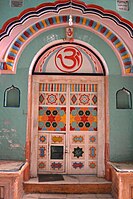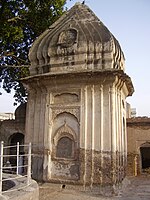|
| |
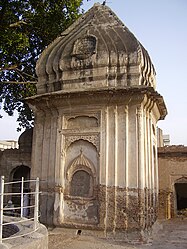 | |
| Total population | |
|---|---|
| 5,392 (
2017) 0.015% of region population | |
| Religions | |
|
Hinduism (majority) including Nanakpanthi, Kalasha and Animists | |
| Languages | |
|
Sanskrit (Sacred) Urdu, Pashto, Hindko, Saraiki, Punjabi |
| Year | Pop. | ±% |
|---|---|---|
| 1881 | 111,892 | — |
| 1891 | 118,881 | +6.2% |
| 1901 | 128,617 | +8.2% |
| 1911 | 119,942 | −6.7% |
| 1921 | 149,881 | +25.0% |
| 1931 | 142,977 | −4.6% |
| 1941 | 180,321 | +26.1% |
| 1951 | 2,432 | −98.7% |
| 1998 | 5,368 | +120.7% |
| 2017 | 5,392 | +0.4% |
| Sources:
Census in Pakistan &
Census of India [1] [2] [3]: 12–21 [4]: 22 [5]: 373 [6]: 344 | ||
Hinduism is a minority religion in the Khyber Pakhtunkhwa province followed by 0.02% of the population of the province as per 2017 Census.
Though having a small population, the Hindu culture has had a very significant element in the history of Khyber Pakhtunkhwa.
In the final census conducted prior to partition in 1941, Hindus constituted approximately 5.9 percent of the population in North-West Frontier Province, [4]: 22 which later amalgamated with the Federally Administered Tribal Areas to become Khyber Pakhtunkhwa. With violence and religious cleansing accompanying the partition of India in 1947, the vast majority departed the region en masse, primarily migrating eastward to states that ultimately fell on the eastern side of the Radcliffe Line including Delhi, East Punjab, Haryana, and Rajasthan.
History
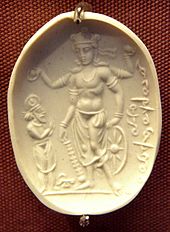
Ancient era
The Gandharan civilization features prominently in the Hindu epic poem, the Mahabharatha, [8] The Vedic texts refer to the area as the province of Pushkalavati. The area was once known to be a great center of learning. [9]
Medieval era



In the first millennium CE, the Khyber Pakhtunkhwa region was ruled by Hindu-Buddhist Turk Shahi and Hindu Shahi dynasties.[ citation needed] During the rule of the Shahis, the Khyber Pakhtunkhwa region was a center of trade. Textiles, gems, and perfumes, as well as other goods had been exported west and into central Asia.
The Shahis were known for their many Hindu temples. These temples were mostly looted and destroyed by later invaders. The ruins of these temples can be found at Nandana, Malot, Siv Ganga, Katas, or Amb, as well as across the west bank of the Indus river at the foothills of the Sulaiman and Hindu Kush mountain ranges, such as at Kafir Kot, Bilot Sharif, or Gumbat. [10] [11] At the height of Shahi rule under king Jayapala, the kingdom had extended to Kabul and Bajaur to the northwest, Multan to the south, and the plains of Punjab to the east. [10] Jayapala, threatened from the consolidation of power by the Ghaznavid dynasty, invaded their capital city of Ghazni. This had initiated the Muslim Ghaznavid and Hindu Shahi struggles. [12]
Over time, Mahmud of Ghazni had pushed further into the subcontinent, as far as east as modern day Agra. During his campaigns, many Hindu temples and Buddhist monasteries had been looted and destroyed, as well as many people being forcibly converted into Islam. [13] Local Pashtun and Dardic tribes converted to Islam, while retaining some of the pre-Islamic Hindu-Buddhist and Animist local traditions such as Pashtunwali and the Attan. [14]
Colonial era
During the colonial era, census reports detailed that much of the indigenous Hindu population in the North-West Frontier Province chiefly belonged to castes and tribes involved in trade such as the Arora, Bhatia, Bhatiara, or Khatri, while others formed part of tribes primarily engaged in agriculture or the military including the Gurjar and Mohyal Brahmin; many of whom form portions of contemporary ethnolinguistic groups such as the Hindkowans, Hazarewals, Kohistanis, or Saraikis. [15] [6]
In a similar manner to the Baloch Hindus to the south, Hindus belonging to the various castes and tribes who were indigenous to the frontier regions had considerable Islamic influence, owing to their status as a religious minority in the region for centuries, and thus formed religious syncretism that incorporated aspects from both faiths into their cultures and traditions. [15] [6] Furthermore, caste differentiation amongst the Hindus of the region was often greatly diminished, in contrast with the Hindus of regions further to the east in the Gangetic plain such as eastern Punjab or the United Provinces. [15] [6]
"The names returned as those of Hindu sects are very numerous amounting in all to 359 different entries. Many of those are caste and tribes such as Agarwal, Arora, Brahman, Bhat, Bhatiara, Chamar, Chuhra, Dhobi, Dogra, Gorkha, Jat, Meo and the like. Some indicate occupations of occupational castes as for instance, Zamindar, Mahajan, Bhishti, Mallah, Nai and Hajjam. A good many more are clan or family names like Kapoor, Sarsut, Muhial, Utradi and Janjua." [15]: 75
" Hinduism, as it exists in the North-West Frontier Province, is but a pale reflection of the system which flourishes in the United Provinces and other areas to the east. Even of the Derajat, where, as we have seen, the Hindu population is proportionately most numerous, the writer of the Dera Ismail Khan Gazetteer notes, "the Hindus of this district are less particular in the matter of caste prejudices and observances than down country Hindus. Most of them will drink water that has been carried in Mussaks (skins for carrying water) or out of lotas detached from a working well. They habitually ride on donkeys and do a multitude of other things which an orthodox Hindu would shrink from. All idolatrous observances are kept very much in the background. Except a few small images (thakurs) kept in their mandirs they have no idols at all. Nor is it their habit to take their gods about in procession. No one, in fact, sees anything of their worship. They burn their dead, and throw the ashes into the Indus. They always keep a few of the bones, and take them, when the opportunity offers, to the Ganges... There are a good many dharamsalas, mandirs, and dawaras at Dera Ismail Khan and in the cis-Indus tehsils"." [15]: 93
"The marriage customs of the Hindus have been influenced by Islam, notably in regard to the age of marriage... Hindu rules regarding commensality between different castes have been relaxed... any distinct caste organization is virtually non-existent in rural areas. Outside the towns Hindus still live in a condition of dependance on their Mohammadan overlords. The Arora, the Khatri, or the Bhatia shop-keeper in a village is a hamsaya of the proprietors of the land; that is to say, he lives rent free in a house which does not belong to him, and in return for this, and for being allowed to reside unmolested in the village, has to render certain services to his protectors." [15]: 93–94— Excerpts from the Census of India ( North-West Frontier Province), 1911 AD
Traditionally, Hindu members of the castes and tribes who were indigenous to the frontier regions of the Indian subcontinent (between the Indus River, Sulaiman range, and the Hindu Kush mountains) had longstanding trading relationships with Afghanistan along with other regions of western and central Asia, which they linked with the Indo-Gangetic Plain of India. Conversely, most of the Hindu migrants in the North-West Frontier Province were involved with the military, primarily concentrated in town cantonments. [15] [6]
"In Hazara, the northernmost district of the Province, the proportion of Hindus to the total population is the smallest (4 per cent). The reason is not far to seek. The Hindus in the Province, are, in the main, dependent upon trade and military service, as the bulk of the Musalman population is supported by agriculture. There are no important centres of trade in Hazara, nor has it any turbulent tribes on its border, as is the case with all trans- Indus districts. The permanent location of certain Gurkha regiments at Abbottabad may be traced to climatic considerations rather than to any military necessity. From the military point of view as well as from the point of view of trade and commerce, Hazara occupies the least important position in the Province and this accounts for the small percentage of Hindu population in this district." [6]: 95
"Next to Dera Ismail Khan, Bannu contains the largest proportion of Hindus and the head-quarters town, Edwardesabad [Bannu], is the only town in the Province where the bulk of the population is Hindu. Practically the whole of internal trade of the district and external trade with the Tochi Agency and through it with Afghanistan is in the hands of the Hindus, who have therefore settled in large numbers at Edwardesabad [Bannu] which is a growing town." [6]: 97
" Dera Ismail Khan has always had the distinction of having the largest proportion of Hindu population. During the last decade the Hindus of no other district showed such improvement in numbers as was noticed in this district (37 per cent). The Powinda trade through the Gomal Pass, which is entirely in the hands of Hindus, is mainly responsible for the large indigenous Hindu population of the district. About 43 per cent of the total Hindus in the district reside at the head-quarters town, which is the chief centre of the Powinda trade." [6]: 98— Excerpts from the Census of India ( North-West Frontier Province), 1921 AD
Immediately prior to 1947 Partition of India, the British held a referendum in the NWFP to allow voters to choose between joining India or Pakistan and 99.02% votes were cast in favor of Pakistan. [16] After the independence of Pakistan in 1947, most of the Hindus left for India. [17]
Demographics
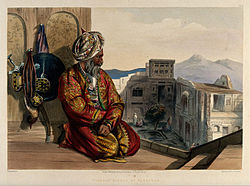
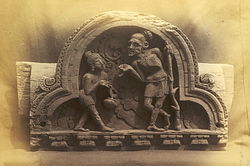


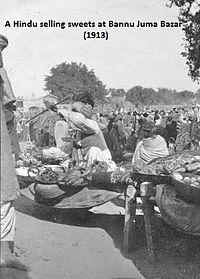

During the colonial era ( British India), prior to the partition in 1947, decadal censuses enumerated religion in North-West Frontier Province, and not in the Federally Administered Tribal Areas. Both administrative divisions later amalgamated to become Khyber Pakhtunkhwa.
Colonial era
According to the 1921 census, the Hindu population in North-West Frontier Province (part of the region that composes contemporary Khyber Pakhtunkhwa) was approximately 149,881, or 6.7 percent of the total population. [6]: 344–345
According to the 1941 census, the Hindu population in North-West Frontier Province (part of the region that composes contemporary Khyber Pakhtunkhwa) was approximately 180,321, or 5.9 percent of the total population. [4]: 22
Districts
At the district level in North-West Frontier Province, as per the 1921 census, the largest Hindu concentrations existed in Dera Ismail Khan District (Hindus formed 15.08 percent of the total population and numbered 39,311 persons), Bannu District (9.53 percent or 23,509 persons), and Kohat District (6.01 percent or 12,879 persons). [6]: 344–346
At the district level in North-West Frontier Province, as per the 1941 census, the largest Hindu concentrations existed in Dera Ismail Khan District (Hindus formed 13.14 percent of the total population and numbered 39,167 persons), Bannu District (10.63 percent or 31,471 persons), and Kohat District (6.06 percent or 17,527 persons).
| District | 1921 [6]: 344–346 | 1931 [5]: 373–375 | 1941 [4]: 22–23 | |||
|---|---|---|---|---|---|---|
| Pop. | % | Pop. | % | Pop. | % | |
| Peshawar District | 48,144 | 5.31% | 42,321 | 4.34% | 51,212 | 6.01% |
| Dera Ismail Khan District | 39,311 | 15.08% | 35,822 | 13.07% | 39,167 | 13.14% |
| Hazara District | 26,038 | 4.18% | 25,260 | 3.77% | 30,267 | 3.8% |
| Bannu District | 23,509 | 9.53% | 26,181 | 9.69% | 31,471 | 10.63% |
| Kohat District | 12,879 | 6.01% | 13,393 | 5.67% | 17,527 | 6.06% |
| Mardan District | — | — | — | — | 10,677 | 2.11% |
| Total Hindus | 149,881 | 6.66% | 142,977 | 5.9% | 180,321 | 5.94% |
| Total Population | 2,251,340 | 100% | 2,425,076 | 100% | 3,038,067 | 100% |
Tehsils
At the tehsil level in North-West Frontier Province, as per the 1921 census, the largest Hindu concentrations existed in Tank Tehsil (Hindus formed 17.14 percent of the total population and numbered 10,224 persons) Dera Ismail Khan Tehsil (15.82 percent or 24,685 persons), Bannu Tehsil (11.32 percent or 16,130 persons), Kulachi Tehsil (9.76 percent or 4,402 persons), and Peshawar Tehsil (9.65 percent or 25,414 persons). [6]: 510–516
At the tehsil level in North-West Frontier Province, as per the 1941 census, the largest Hindu concentrations existed in Dera Ismail Khan Tehsil (Hindus formed 16.03 percent of the total population and numbered 30,065 persons), Bannu Tehsil (13.07 percent or 24,517 persons), Hangu Tehsil (9.52 percent or 5,909 persons), Tank Tehsil (9.48 percent or 5,279 persons), and Peshawar Tehsil (8.62 percent or 33,551 persons). [4]: 30
| Tehsil | 1921 [6]: 510–516 | 1931 [5]: 393–396 | 1941 [4]: 30 | |||
|---|---|---|---|---|---|---|
| Pop. | % | Pop. | % | Pop. | % | |
| Peshawar Tehsil | 25,414 | 9.65% | 23,538 | 8.44% | 33,551 | 8.62% |
| Dera Ismail Khan Tehsil | 24,685 | 15.82% | 25,982 | 15.19% | 30,065 | 16.03% |
| Bannu Tehsil | 16,130 | 11.32% | 17,789 | 10.99% | 24,517 | 13.07% |
| Abbottabad Tehsil | 13,580 | 5.85% | 13,378 | 5.27% | 17,558 | 5.69% |
| Nowshera Tehsil | 10,638 | 7.15% | 9,271 | 5.77% | 15,128 | 6.93% |
| Tank Tehsil | 10,224 | 17.14% | 5,109 | 9.98% | 5,279 | 9.48% |
| Marwat Tehsil | 7,379 | 7.08% | 8,392 | 7.74% | 6,954 | 6.42% |
| Haripur Tehsil | 7,362 | 4.54% | 7,016 | 4.13% | 7,278 | 3.87% |
| Mardan Tehsil | 6,846 | 3.99% | 5,941 | 2.99% | 8,709 | 2.91% |
| Kohat Tehsil | 6,415 | 8.31% | 7,615 | 8.62% | 9,156 | 7.99% |
| Mansehra Tehsil | 4,592 | 2.29% | 4,308 | 2.06% | 4,910 | 2.02% |
| Kulachi Tehsil | 4,402 | 9.76% | 4,731 | 9.12% | 3,823 | 6.97% |
| Hangu Tehsil | 4,225 | 9.45% | 2,990 | 6.65% | 5,909 | 9.52% |
| Swabi Tehsil | 3,063 | 1.92% | 1,426 | 0.9% | 1,968 | 0.95% |
| Teri Tehsil | 2,239 | 2.43% | 2,788 | 2.71% | 2,462 | 2.18% |
| Charsadda Tehsil | 2,183 | 1.33% | 2,145 | 1.21% | 2,533 | 1.04% |
| Amb Tehsil | 440 | 2.02% | 509 | 1.63% | 433 | 0.9% |
| Phulra Tehsil | 64 | 1.12% | 49 | 0.74% | 88 | 1.01% |
| Total Hindus | 149,881 | 6.66% | 142,977 | 5.9% | 180,321 | 5.94% |
| Total Population | 2,251,340 | 100% | 2,425,076 | 100% | 3,038,067 | 100% |
Cities
According to the 1921 census, the Hindu population in urban portions of North-West Frontier Province was approximately 94,662, or 28.2 percent of the total urban population. [6]: 340–342 Cities/ urban areas in North-West Frontier Province with the largest Hindu concentrations included Bannu (Hindus formed 59.4 percent of the total population and numbered 13,222 persons), Abbottabad (53.94 percent or 7,346 persons), Jamrud (50.82 percent or 3,114 persons), Haripur (44.76 percent or 2,636 persons), and Dera Ismail Khan (43.41 percent or 17,077 persons). [6]: 340–342
According to the 1941 census, the Hindu population in urban portions of North-West Frontier Province was approximately 134,382, or 24.3 percent of the total urban population. [4]: 19 Cities/ urban areas in North-West Frontier Province with the largest Hindu concentrations included Bannu (Hindus formed 57.59 percent of the total population and numbered 22,175 persons), Dera Ismail Khan (44.47 percent or 22,815 persons), Risalpur (43.71 percent or 3,937 persons), Abbottabad (43.34 percent or 11,886 persons), and Lakki (36.58 percent or 3,710 persons). [4]: 19
| City/ Urban Area | 1921 [6]: 340–342 | 1931 [5]: 257–259 | 1941 [4]: 19 | |||
|---|---|---|---|---|---|---|
| Pop. | % | Pop. | % | Pop. | % | |
| Peshawar [d] | 20,981 | 20.09% | 21,973 | 18.03% | 31,630 | 18.24% |
| Dera Ismail Khan [d] | 17,077 | 43.41% | 16,761 | 41.56% | 22,815 | 44.47% |
| Bannu [d] | 13,222 | 59.4% | 15,036 | 49.24% | 22,175 | 57.59% |
| Abbottabad [d] | 7,346 | 53.94% | 7,753 | 47.96% | 11,886 | 43.34% |
| Nowshera [e] | 6,192 | 22.32% | 4,675 | 16.14% | 9,831 | 22.33% |
| Kohat [d] | 5,796 | 20.81% | 6,709 | 19.53% | 8,250 | 18.34% |
| Tank [f] | 4,197 | 38.7% | 2,244 | 34.95% | 3,296 | 36.26% |
| Risalpur | 3,369 | 39.64% | 2,900 | 36.18% | 3,937 | 43.71% |
| Mardan [d] | 3,220 | 29.46% | 3,605 | 13.72% | 5,851 | 13.77% |
| Jamrud | 3,114 | 50.82% | — | — | — | — |
| Haripur | 2,636 | 44.76% | 2,693 | 35.19% | 3,113 | 33.39% |
| Lakki [f] | 2,543 | 34.02% | 2,805 | 36.41% | 3,710 | 36.58% |
| Kulachi [f] | 2,162 | 27.38% | 2,182 | 25.9% | 2,092 | 23.67% |
| Nawan Shehr [f] | 1,052 | 20.66% | 883 | 17.21% | 1,030 | 16.06% |
| Baffa [f] | 861 | 11.32% | 762 | 10.5% | 735 | 9.2% |
| Charsadda | 484 | 4.73% | 519 | 4.5% | 745 | 4.42% |
| Tangi | 314 | 3.19% | 362 | 4.17% | 444 | 3.44% |
| Cherat | 80 | 30.65% | 158 | 18.74% | 30 | 8.9% |
| Parang | 16 | 0.16% | 16 | 0.16% | 2 | 0.01% |
| Mansehra | — | — | 1,091 | 18.88% | 1,699 | 16.63% |
| Kot Najibullah | — | — | — | — | 929 | 17.48% |
| Utmanzai | — | — | — | — | 182 | 1.8% |
| Total Urban Hindu Population | 94,662 | 28.19% | 93,127 | 24.12% | 134,382 | 24.34% |
| Total Urban Population | 335,849 | 100% | 386,177 | 100% | 552,193 | 100% |
Modern era
According to the 1998 Census, there are 5,090 Hindus (including the Scheduled Castes) constituting 0.029% of the population of Khyber Pakhtunkhwa. [19]
In the 2017 Census, there were 5,392 Hindus constitutes 0.015% of the population. [20] However, Pakistan Hindu Council estimates that there are 21,033 Hindus in Khyber Pakhtunkhwa. [21]
Community life
In Peshawar, the capital of Khyber Pakhtunkhwa, Hindus enjoy religious freedom and live peacefully alongside the Muslims. The city of Peshawar today is home to four Hindu tribes– the Balmiks, the Rajputs, the Heer Ratan Raths and the Bhai Joga Singh Gurdwara community. Since partition, the four tribes have lived in harmony with all religious communities including Muslims. However, there is the lack of upkeep of the dilapidated Hindu temples in the city. The local government always fails to assign caretakers and priests at temples. [22] But in other parts of Khyber Pakhtunkhwa like Buner, Swat and Aurakzai districts, Hindu and Sikh families have been targeted by the Taliban for failing to pay Jizya (religious tax). Due to this, more than 150 Sikhs and Hindu families in Pakistan's have moved to Hasan Abdal and Rawalpindi in Punjab in 2009. [23]
The Kalasha people practice an ancient form of Hinduism mixed with animism. [24] [25] They are considered as a separate ethnic religion people by the government of Pakistan. [26] They reside in the Chitral District of Khyber-Pakhtunkhwa province. [27]
Mansehra Shiv Temple is one of the oldest Hindu temples in Pakistan that is still in existence. It is at least 2000 [28] to 3000 years old. [29] Panj Tirath is another historic Hindu temple in Pakistan. [30] [31] In 2020, Karak temple attack, historic Hindu temple and Samadhi in Karak district was demolished and burnt by a mob of 1,500 local Muslims led by a local Islamic cleric and the supporters of Jamiat Ulema-e-Islam party. [32] [33]
Temples
See also
Notes
-
^ Pre-partition populations for religious data is for
North-West Frontier Province only and excludes the
Federally Administered Tribal Areas (both administrative divisions later merged to form Khyber Pakhtunkhwa in 2018), as religious data was not collected in the latter region at the time.
1951, 1998, and 2017 populations for religious data combine the North-West Frontier Province and Federally Administered Tribal Areas, both administrative divisions which later merged to form Khyber Pakhtunkhwa in 2018. - ^ Temple D—per Meiser's designations—near the main gateway to the north. The complex has four temples.
- ^ Temple B, per Meiser's designations. The complex has eight temples.
- ^ a b c d e f Includes total Municipality and Cantonment population.
- ^ Includes total Cantonment and Notified area population.
- ^ a b c d e Includes total Notified area population.
References
- ^ "TABLE 9 - POPULATION BY SEX, RELIGION AND RURAL/URBAN" (PDF). Retrieved 9 February 2023.
- ^ "Population Distribution by Religion, 1998 Census" (PDF). Retrieved 9 February 2023.
- ^ "CENSUS OF PAKISTAN, 1951 POPULATION ACCORDING TO RELIGION TABLE 6" (PDF). Retrieved 9 February 2023.
- ^ a b c d e f g h i "Census of India, 1941. Vol. 10, North-West Frontier Province". 1941. JSTOR saoa.crl.28215543. Retrieved 24 February 2024.
- ^ a b c d "Census of India, 1931, vol. XV. North-west frontier province. Part I-Report. Part II-Tables". 1931. JSTOR saoa.crl.25793233. Retrieved 24 February 2024.
- ^ a b c d e f g h i j k l m n o p "Census of India 1921. Vol. 14, North-west Frontier Province : part I, Report; part II, Tables". 1921. JSTOR saoa.crl.25430163. Retrieved 24 February 2024.
- ^ Buddhism in Central Asia by Baij Nath Puri p.131
- ^ "Imperial Gazetteer2 of India, Volume 19, page 148 – Imperial Gazetteer of India – Digital South Asia Library". Retrieved 4 June 2021.
- ^ Bhattacharya, Avijeet. Journeys on the Silk Road Through Ages. Zorba. p. 187.
- ^ a b ( Wynbrandt 2009, pp. 52–54)
- ^ ( Wink 1991, p. 125)
- ^ ( Holt et al 1977, p. 3)
- ^ ( Wynbrandt 2009, pp. 52–55)
- ^ ( Tomsen 2013, p. 56)
- ^ a b c d e f g "CENSUS OF INDIA, 1911 VOLUME XIII NORTH-WEST FRONTIER PROVINCE". Retrieved 10 February 2023.
- ^ Jeffrey J. Roberts (2003). The Origins of Conflict in Afghanistan. Greenwood Publishing Group. pp. 108–109. ISBN 9780275978785. Retrieved 18 April 2015.
- ^ Zamindar, Vazira Fazila-Yacoobali (2010). The Long Partition and the Making of Modern South Asia: Refugees, Boundaries, Histories. Columbia University Press. pp. 40. ISBN 978-0-231-13847-5.
-
^
"Atmaran, Hindoo of Peshawar". Retrieved 14 March 2023.
"Atmaran, Hindoo of Peshawar" is the title of a coloured lithograph made by E. Walker (d. 1882), based on the work of James Rattray (1818-1854), who was based in Afghanistan during the First Anglo-Afghan war (1838-1842). Atmaram was a Hindu from Peshawar in modern northern Pakistan, who had become the 'minister' of a local Muslim and Uzbek ruler in northern Afghanistan, Mohammad Murad Beg of Kunduz.
- ^ "Population Distribution by Religion, 1998 Census" (PDF). Pakistan Bureau of Statistics. Archived (PDF) from the original on 26 December 2016. Retrieved 4 June 2021.
- ^ "SALIENT FEATURES OF FINAL RESULTS CENSUS-2017" (PDF). Retrieved 4 June 2021.
-
^
"Hindu Population (PK) – Pakistan Hindu Council". Archived from the original on 15 March 2018. Retrieved 24 May 2021.
{{ cite web}}: CS1 maint: unfit URL ( link) - ^ "Across religious divides: A harmonious haven for Hindus in Khyber-Pakhtunkhwa". The Express Tribune. 14 October 2019.
- ^ "Sikhs and Hindu families move to Pak Punjab". NDTV. 3 May 2009.
- ^ Witzel, Michael (2004), "Kalash Religion (extract from 'The Ṛgvedic Religious System and its Central Asian and Hindukush Antecedents')" (PDF), in A. Griffiths; J. E. M. Houben (eds.), The Vedas: Texts, Language and Ritual, Groningen: Forsten, pp. 581–636
- ^ pace Fussman 1977
-
^ Akbar, Ali (4 April 2017).
"Peshawar High Court orders govt to include Kalasha religion in census".
Dawn. Retrieved 11 July 2017.
Kalasha, the religion followed by Kalash community, lies between Islam and an ancient form of Hinduism.
- ^ Lazaridis, Iosif; Nadel, Dani; Rollefson, Gary; Merrett, Deborah C.; Rohland, Nadin; Mallick, Swapan; Fernandes, Daniel; Novak, Mario; Gamarra, Beatriz; Sirak, Kendra; Connell, Sarah (2016h). "Genomic insights into the origin of farming in the ancient Near East". Nature. 536 (7617): 419–424. Bibcode: 2016Natur.536..419L. doi: 10.1038/nature19310. ISSN 1476-4687. PMC 5003663. PMID 27459054.
- ^ "Pakistan prepares to hold a major Hindu festival Maha Shivaratri". Asia. Gulf News. TNN. 17 February 2020. Retrieved 4 June 2021.
- ^ "Mansehra's Shiv temple". Fridaytimes. TNN. 14 August 2014. Retrieved 4 June 2021.
- ^ "Panj Tirath: Heritage Lost to the Ravages of Time". The Friday Times. 2019-02-15. Retrieved 2021-06-06.
- ^ Scroll Staff. "Pakistan declares ancient Hindu religious site Panj Tirath to be national heritage". Scroll.in.
- ^ "Pakistan arrests more than a dozen over Hindu temple attack". Aljazeera. 31 December 2020. Retrieved 4 June 2021.
- ^ Imtiaz Ahmad (31 December 2020). "Hindu temple in Pakistan vandalised, set on fire". Hindustan Times. Retrieved 4 June 2021.
Works cited
- P. M. Holt; Ann K. S. Lambton; Bernard Lewis, eds. (1977). The Cambridge history of Islam. Cambridge University Press. ISBN 0-521-29137-2.
- Tomsen, P. (2013). The Wars of Afghanistan: Messianic Terrorism, Tribal Conflicts, and the Failures of Great Powers. PublicAffairs. ISBN 978-1-61039-412-3. Retrieved 2018-05-06.
- Wink, Andre (1991). Al- Hind: The slave kings and the Islamic conquest. E.J Brill.
- Wynbrandt, James (2009). A Brief History of Pakistan. New York: Infobase Publishing.

